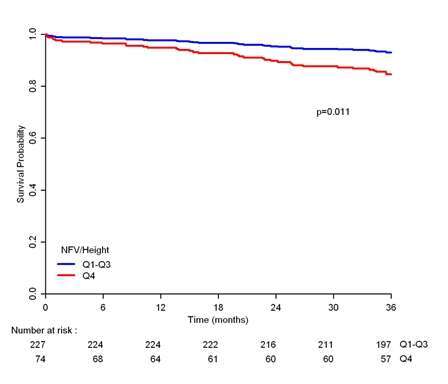
The Association Between Neck fat Volume and Long-Term Outcome
Introduction: Anthropometric indices of obesity (e.g. body mass index and waist circumference) are associated with poor long-term outcome. Prior studies have associated between neck circumference and central body adiposity. We explored the association between neck fat volume (NFV) and long-term outcome.
Methods: Retrospective analysis of all patients undergoing computerized tomography angiography (CTA) for suspected cerebrovascular accident during 2013. Pediatric patients and those with malignancy were excluded. NFV was measured by 3D reconstruction. To adjust for differences in body size, NFV was adjusted to the patient’s height thus yielding the NFV/height ratio (NHR). Univariate and multivariate analysis were utilized to establish the association between various indices and all-cause mortality.
Results: The final cohort included 302 patients. The average age was 61.9±14.3 years, 60.6% of whom were male. Diabetes mellitus, hypertension and cardiovascular disease were frequent in 31.5%, 69.9%, and 72.2% of patients, respectively. The median NHR was 492.53 [IQR 393.93-607.82] cc/cm. Median follow up time was 41.2 months, during which 40 patients (13.2%) died. Multivariate analysis adjusting for age, sex and diabetes mellitus indicated an independent association between the upper quartile of NHR and all-cause mortality (hazard ratio= 2.279; 95% CI= 1.209-4.299; p =.011, figure).
Conclusion: NHR is a readily available anthropometric index significantly correlated with poor long-term outcome. Following validation in larger scale studies, this index may serve a screening index for disease and mortality prevention.
Figure: Kaplan Meier Survival Curve of patients in the upper quartile of NHR compared with the quartiles 1-3.

Powered by Eventact EMS